Staying with the theme of the week - “firsts” - let’s look at 1964, the first year of the Late Model Modifieds.
Since local stock car racing began at Cumberland Speedway in 1948 the cars had been based off “hot rods”, or modified stock cars from the 1930’s. Through the 1950s everything on the cars evolved: the engines went from Flathead Fords to Chevy V-8s, the suspensions, rear ends, and of course safety equipment all made huge improvements. But the frames and the bodies of the cars remained virtually unchanged.
The problem was, by now most of the cars were right at 30 years old. Replacement parts weren’t as easy to locate as they were in the early days of the sport. Tracks throughout the area were seeing drops in attendance and car counts were falling off as well. Many tracks made the decision to change over to the full-bodied cars, or the Late Model Modified division, as it was being called. The Nashville Fairgrounds wanted to wait one more year, but the writing was on the wall.
Click on the photo to see the mandate of October 31, 1963.
P.B. Crowell, an owner of three Modified coupes, said, “I’m fixing to quit. I’m not building anything”.
Another three-car team owner Bill Dyer offered his opinion. “There’s no way in the world it can work. I’m not going to build one. I’m stuck with three modifieds and I’ll sell them if I can.”
Two drivers who were stars in the Hobby cars (the support division to the coupes) saw this as an opportunity to move up to the premier division. Charlie Binkley wanted to make the move for the 1963 season but couldn’t find the money. Walter Wallace and car owner Frank Wilson saw the opportunity to start off on a level playing field. No one would know any secrets about the cars in the new division.
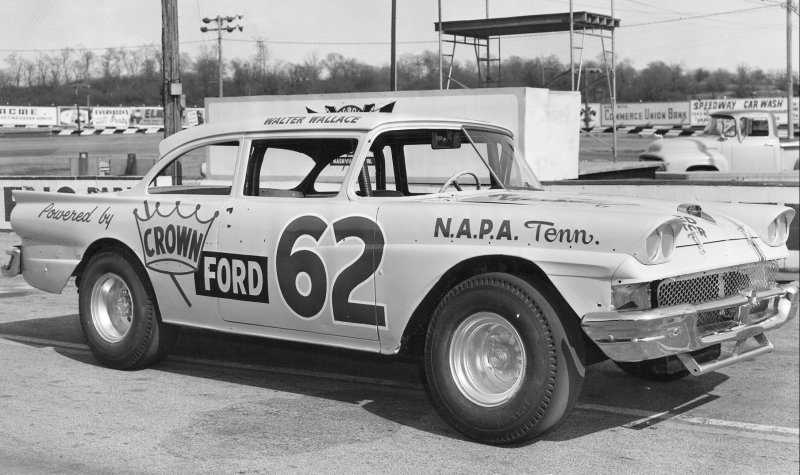 | ||
| Walter Wallace had his new car ready to go well before the season started. |
It was early Spring when Wallace took his car out for its first shakedown runs. Notice in this early footage they are still running a stock wheel on the left front.
Three of the biggest stars from the coupes really didn't make the transition to the new cars. Bob Reuther and Malcolm Brady, both former track champions, retired from driving. Eddie Mitchell, another fan-favorite in the black “Poor 4” never drove another race at the Fairgrounds. He continued to run the coupes at Highland Rim, Sulpher Dell, and other area tracks.
Bill Dyer relented and built a 1961 Pontiac for Herb Lewis. Coo Coo Marlin built a 1958 Chevy on his farm in Columbia. Frank Wilson built a 1958 Ford for Wallace, while the Binkley clan fielded a 1955 Chevy. Long time owner Stan Starr had a 1956 Chevy ready for Jimmy Allen. Jimmy Griggs and his brother built a 1957 Chevy. Policeman Bob Hunley showed up with a ’56 Chevy.
As could be expected with a new division, the opening race had a car count that was less than hoped for. Thirteen cars took the green flag on April 18, with Herb Lewis leading the first 9 laps. Lewis was sidelined when the coil wire came off, and Coo Coo Marlin took the lead. Walter Wallace already had track time in his Ford after running at Birnimgham before the Nashville season started, and took the lead from Marlin with 3 laps to go to become the first feature winner in the full-bodied cars. Binkley and Griggs were eliminated in accidents.
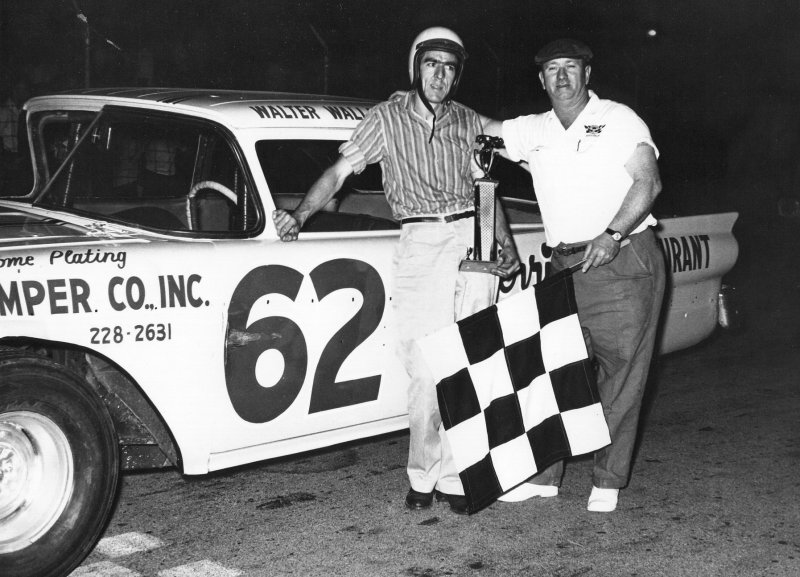 |
| Billy Rolin snapped this photo of Forrest Prince awarding Walter Wallace the trophy for the first race in the Late Model Modifieds on April 18, 1964. |
Keep in mind, the Saturday night features were still being held on the quarter-mile track. Only special races held on Sunday afternoon were contested on the half-mile, as lights wouldn’t be installed on the big track until after the ’64 season.
The second race night was rained out, so for what would be the second race, a strong contingent of out-of-towners showed up. Freddy Fryar, Friday Hassler, Bobby Allison, and Joe Lee Johnson all towed to Nashville to see how their new late model cars fared against the locals. Lewis started from the pole, but Charlie Binkley moved from his 6th starting position to win his first race in the main division. He was followed by Lewis, Fryar, Wallace, and Hassler. A mechanic from a rival team put up the $25.00 protest fee to check the stroke on Binkley’s engine, but he was found to be in compliance with the rules and his win stood.
Howard Johnson took these photos of some of the cars after one of the Saturday night features.
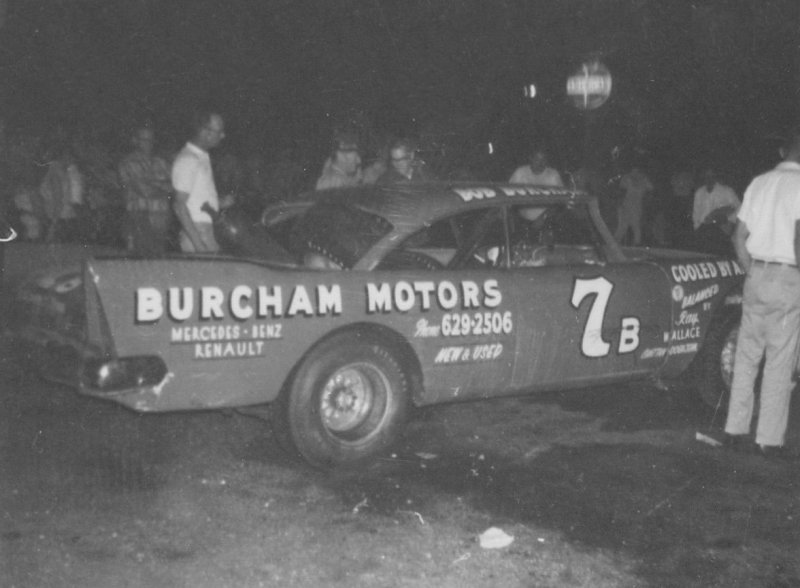 |
| Bob Burcham drove this 1958 Plymouth |
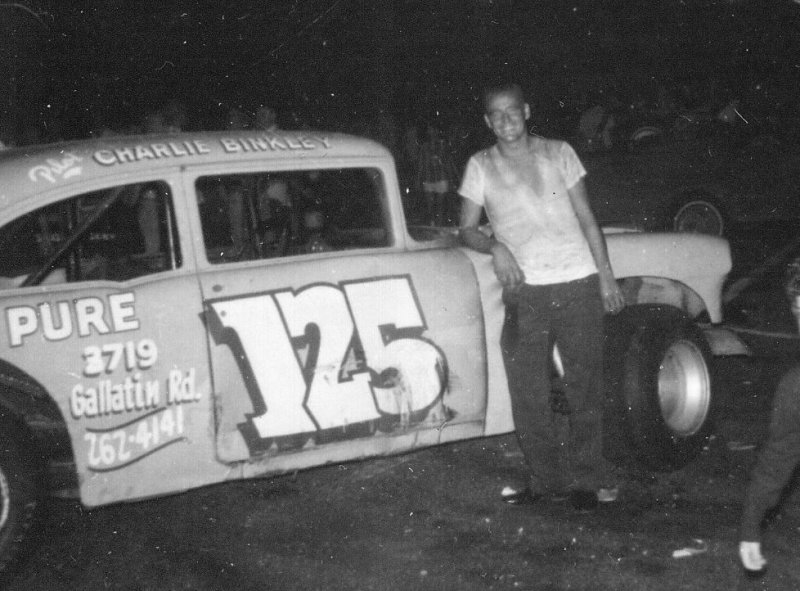 |
| Charlie Binkley won 6 features in this Chevy |
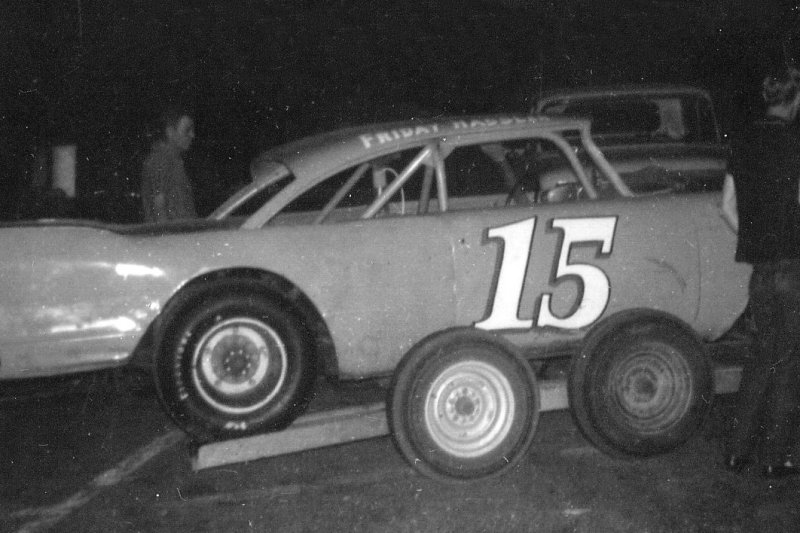 |
| Friday Hassler was strong in his Plymouth |
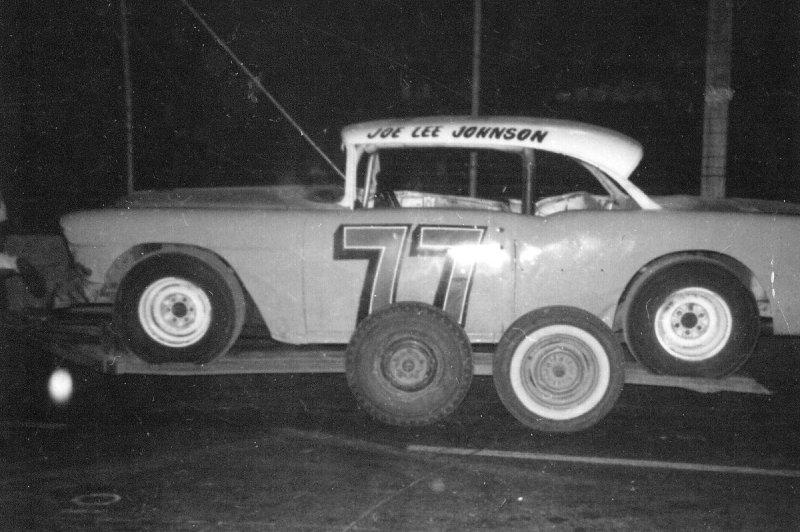 |
| Joe Lee Johnson won two features in this 1957 Chevy |
Lewis won the next race, becoming the first of what would ultimately be 7 drivers to win in both the coupes and the full-bodied cars.
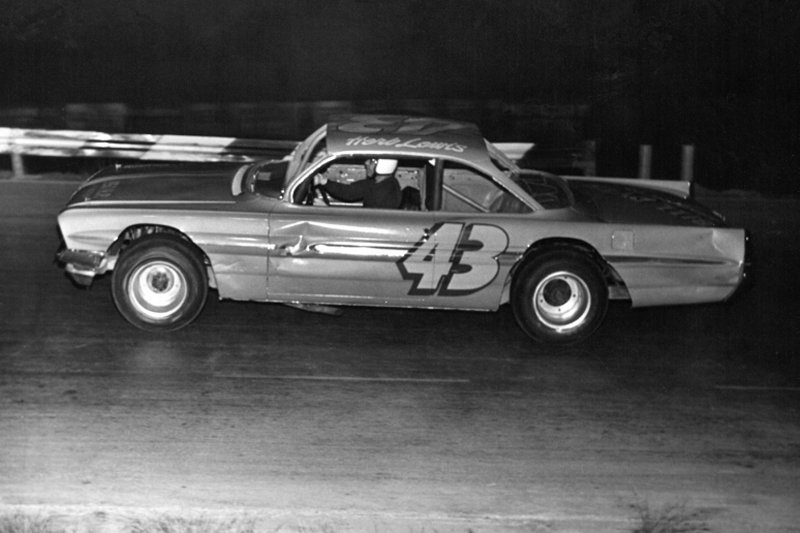 |
| Herb Lewis drove this Bill Dyer prepared Pontiac to a win on May 16 |
The next five races would see only one winner. Charlie Binkley went on a tear and won five in-a-row, with Freddy Fryar finishing second in all five races. The final race of Binkley’s streak saw a scary accident as Herb Lewis went over the turn two wall in his Pontiac. Lewis was dazed and suffered a broken tailbone that sidelined him almost a month. Luckily, no spectators were injured.
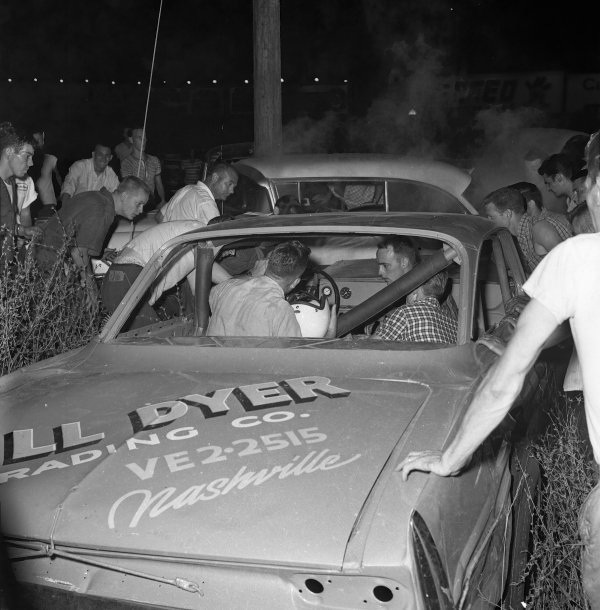 |
| Crew members from other teams are the first to reach Lewis and help get his helmet off |
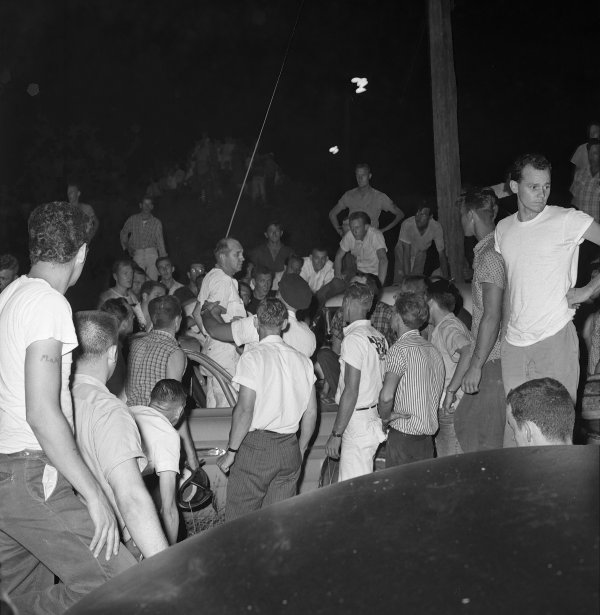 |
| Lewis is helped from his car after going over the turn 2 wall of the quarter-mile |
A race on the half-mile cooled Binkley off as Bobby Allison beat brother Donnie with Fryar finishing 3rd one lap down. Binkley was 7th two laps down. Twenty-one cars started the first race for the big cars on the half-mile. The race was run caution free, and that surprised Donnie Allison to the point he didn’t realize the race was almost over until he saw the white flag. He said he had just been riding and with a lap or two notice the race was nearing its close he could have passed Bobby for the win. Of course this was in the days prior to radios being used for communication from the crew to the driver. Pole sitter Red Farmer and Friday Hassler both blistered tires and had to back off in the late stages, finishing 11th and 12th respectively.
A return to the quarter-mile the following week saw Coo Coo Marlin take his first checkered flag of the season. Nine cars were on the lead lap at the finish, a high for the season so far. Fryar, Marlin, and Wallace all earned wins before they returned to the half-mile in July. Friday Hassler drove a 1958 Plymouth to his first Nashville win since the ’63 Southern 300.
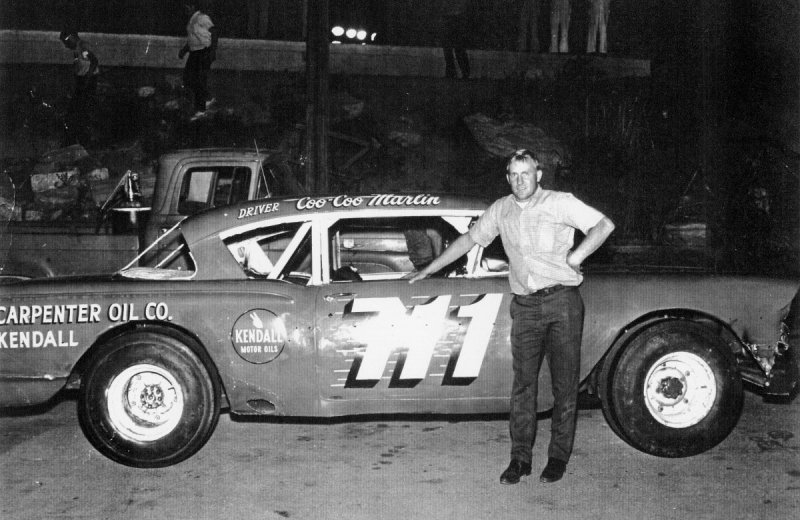 |
| Coo Coo stands beside his '58 Chevy |
Just before the July race on the half-mile, Herb Lewis returned to the cockpit to run a few practice laps in his rebuilt car. You can see the hood and both front fenders had to be replaced. From the looks of his hand motions, Herb isn't pleased with the shocks or springs that are under the car.
Car counts were rising every week and more drivers and mechanics were figuring out what it took to make the heavy cars run fast. When they returned to the small track L. J. Hampton drove a car owned by Hart Hastings to victory lane, and the next week Joe Lee Johnson was the winner. After the break for the Nashville 400 Grand National race Freddy Fryar made a strong stretch run for the championship, winning three in-a-row.
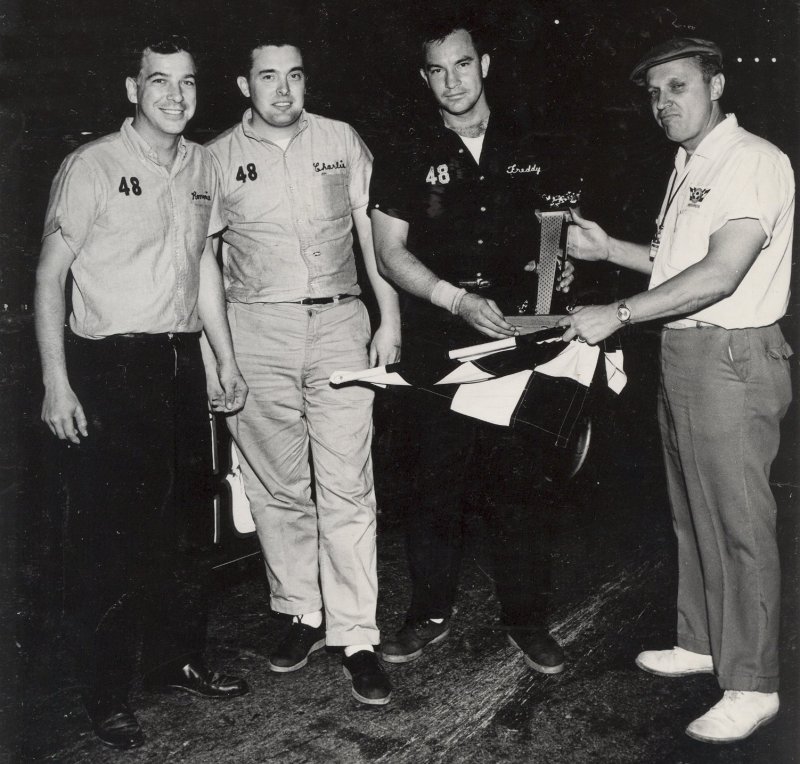 |
| Freddy Fryar and crew receive the winner's trophy from Bennie Goodman |
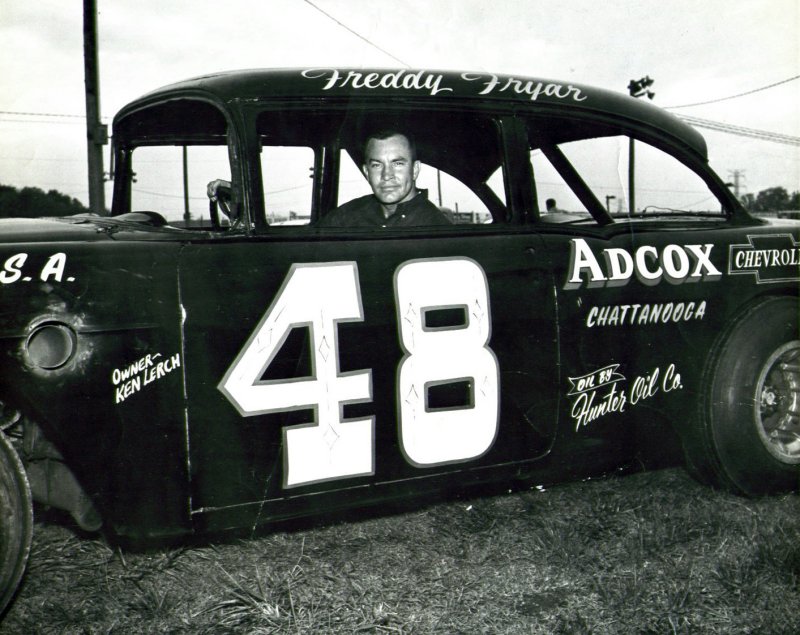 |
| Fryar at the wheel of his black '56 Chevy |
The season wound down with a 100-lapper on the half-mile on Labor Day, a 100-lap race on the quarter-mile, and the Southern 300. Bob Burcham won the Labor Day race on the half-mile, Joe Lee Johnson won the last premier division race to be held on the quarter-mile, and Burcham appeared to be on his way to a win in the Southern 300 when the engine in his Plymouth blew with two laps to go, handing the win to Bobby Allison. Binkley had been the fastest car on the track, but two green flag pit stops put him a laps down. He was charging through the field when his engine blew on lap 254. Twenty-nine cars started the 300-lap race with Allison and Joe Lee Johnson being the only cars to complete all 300 laps. Burcham was credited with third, Red Farmer 4th, and Coo Coo Marlin was 5th. Marty Robbins finished 6th after starting 10th in his Plymouth. Allison won $1,000 for his day's work.
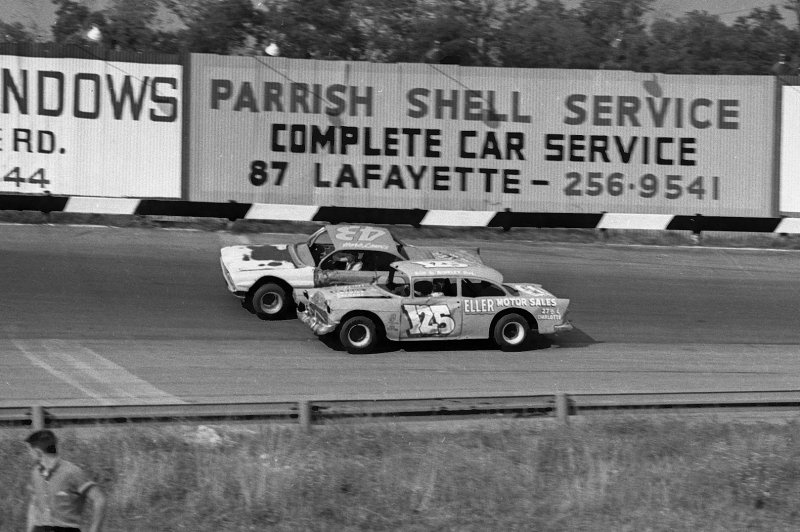 |
| Charlie Binkley dives under Herb Lewis in turn 3 on the half-mile |
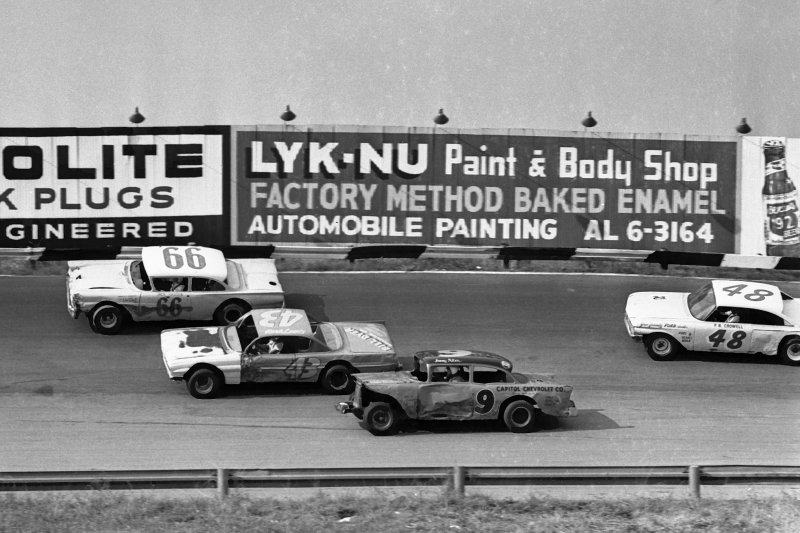 |
| Jack Hardin (66), Herb Lewis (43), Jimmy Allen (9), and P.B. Crowell (48) |
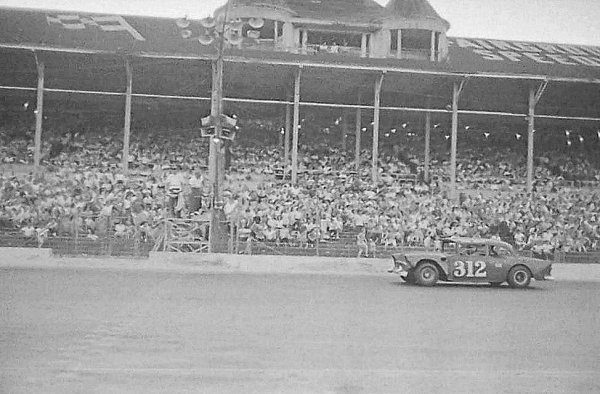 |
| Bobby Allison takes the checkered flag in the 1964 Southern 300 |
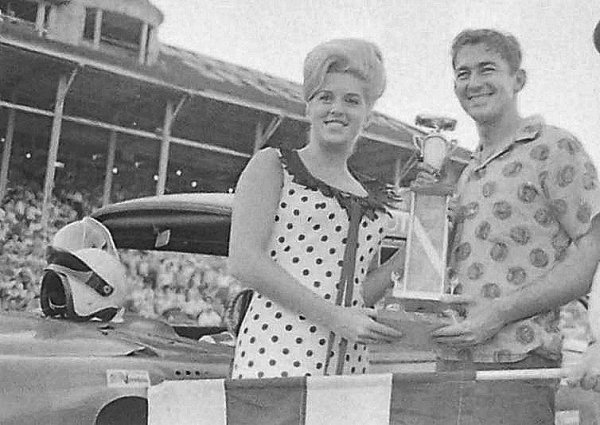 |
| Bobby Allison in victory lane after the 1964 Southern 300 |
Another scary moment happened during the Southern 300. On lap 103 Walter Wallace spun coming off turn two. Bill Gregg and Freddy Fryar crashed trying to avoid Wallace. Safety crews were already on the scene cleaning up the wreck. In the age before fuel cells, both the Wallace and Fryar cars and gas leaking from their tanks. As the field rode behind the pace car under the yellow flag, one of the cars backfired and the flame from the exhaust ignited the gas. Half of the backstraight turned into an inferno. Thankfully the fast acting Acme fire crew extinguished the flames, but as you can see from the photos it looked bad for a while.
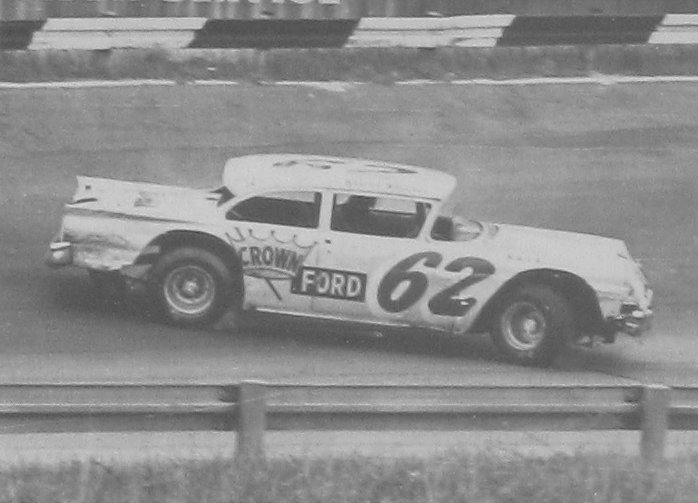 |
| Walter Wallace spins coming off turn 2 |
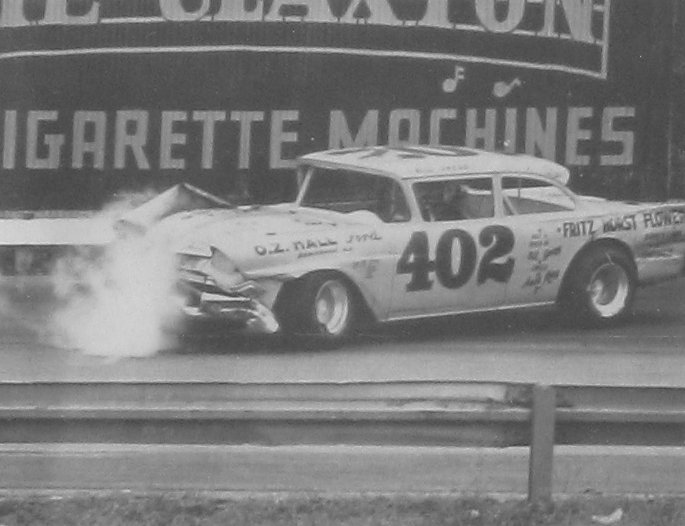 |
| Bill Gregg crashes with Freddy Fryar trying to avoid Wallace |
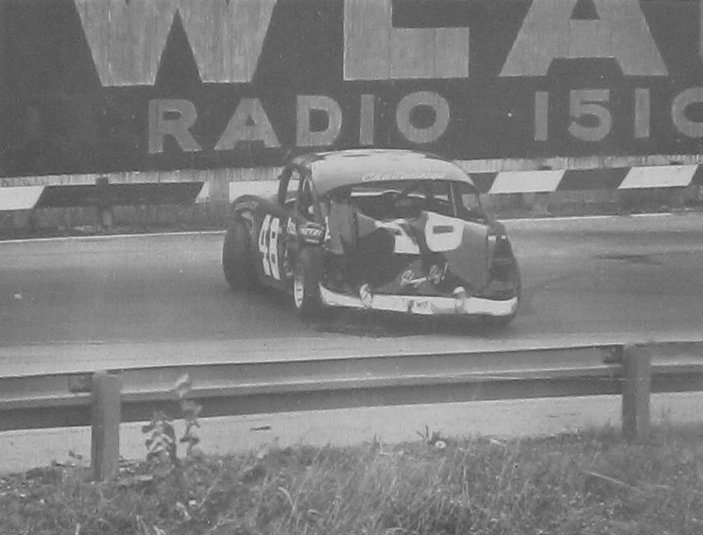 |
| Fryar's car with damage to the rear end |
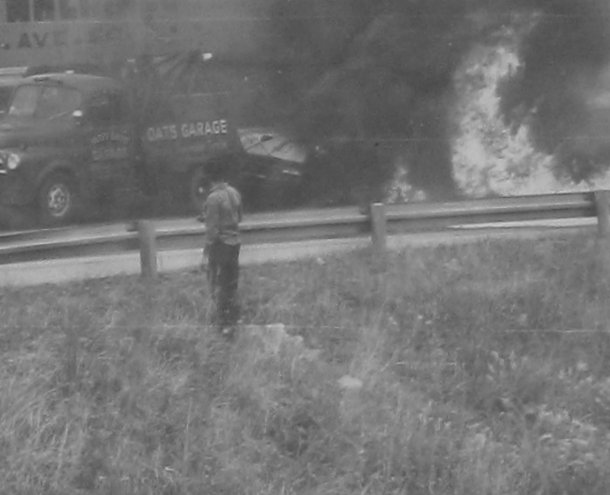 |
| The wrecker from Pappy Oats' garage was already hooked up to Wallace when the fire started |
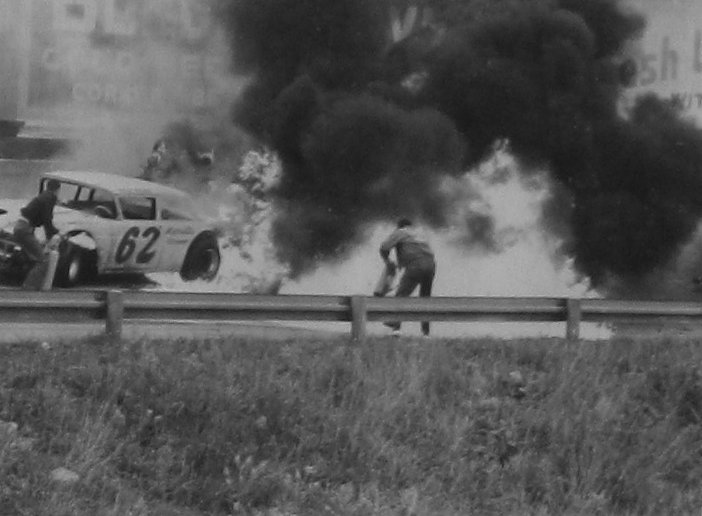 |
| Safety workers did a great job getting the fire contained |
Freddy Fryar won the championship over Coo Coo Marlin, Charlie Binkley, Walter Wallace, and Joe Lee Johnson. Binkley was the big winner of the season with 6 wins in 22 races, while champion Fryar won four races.
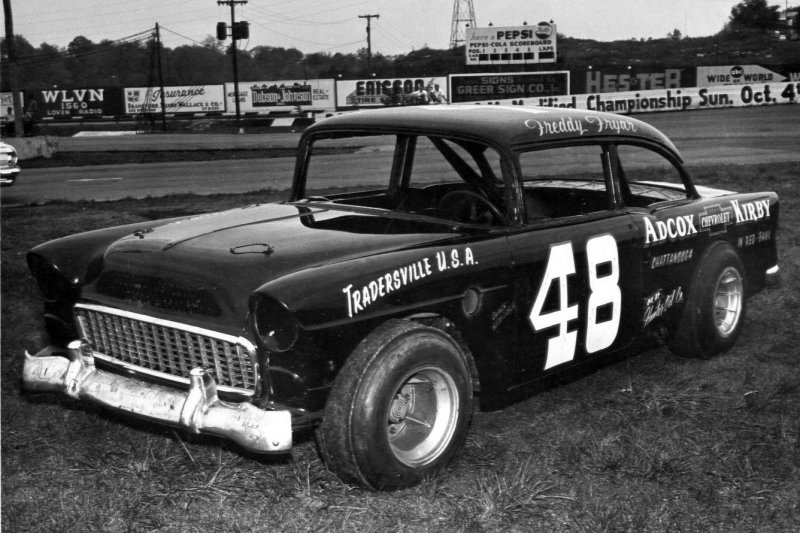 |
| The car Freddy Fryar drove to the 1964 track championship |
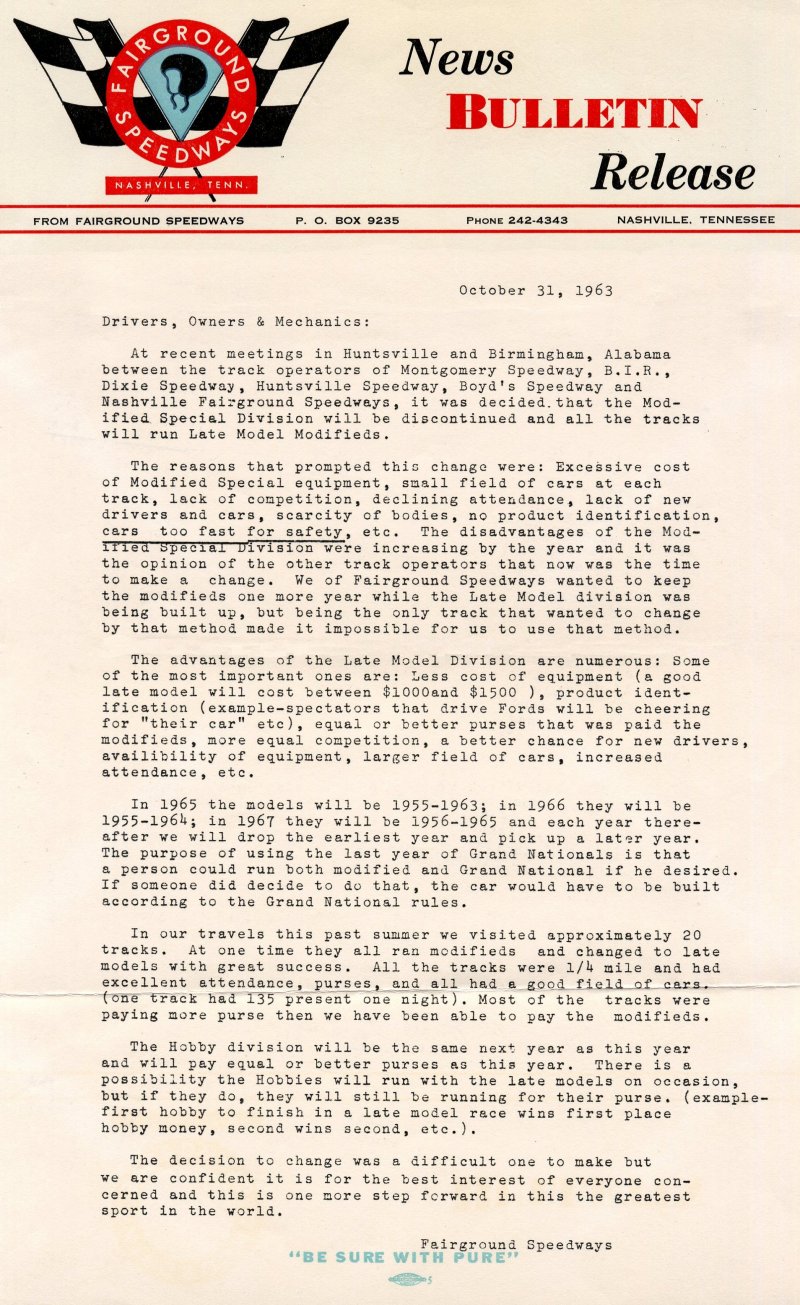
Russ, you are doing a great job. Keep it up!
ReplyDeleteI was amazed to see the total car count for the Late Model Modified race in 1964 was 13. Fast forward to April 7th, 1984, the first race for the Late Model Stock Cars...car count for the first race: 13.
One other note, the first live LMSC event televised nationally (USA Network, Ken Squire) in May of 1984 had how many cars start? 13.
What a coincidence!
Joe Williams
Russ,you're better than any track program..Now,how many races were run on the half mile in 1964?(I know Sunday only).I know the Saturday night shows were all ran on the 1/4 mile,but how many divisions raced on Sat.nights in 64!
ReplyDelete@Joe-
ReplyDeleteThanks for the kind words.
The car count got me curious as to how many cars they had when they switched from the LMS division to the Grand American cars in 1980. Not really an apples to apples comparison for two reasons.
One, it was a 200-lap race, and some out of town guys came in (including Butch Lindley and David Pearson!) and two, it seems there were LMS cars allowed to run. The race results show 3 Novas, an Omega, a Ventura, and a Granada. Definitely not Grand Am body styles.
I'll have to dig into that some more.
@Randy-
There were 4 LMM races run on the half-mile in '64. Fifty-lappers in both June and July, a 100-lap race on Labor Day, then the Southern 300.
There was also an ARCA race in May, a 200-lap GN race in June, and the Nashville 400 GN race in August. So 7 race dates total.
On the June and July LMM races, they ran a regular 30-lap feature on Saturday night on the quarter-mile then came right back on Sunday and ran the same cars on the half! So you'd get all the big names from out of town come here and do a two-fer - since they were here they'd run the Saturday night race as well as the Sunday race. So you'd have the Allisons, Farmer, Hassler, Johnson, and others in a regular Saturday night 30-lap feature!
To answer your other question, there were two divisions running on Saturday night. The season started with the Hobby cars. They ran the first six weeks then they did away with the division, took a week off, and came back with the cadet cars. Boyd Adams won the last Hobby race, George Bennett won the first Cadet race.
I think I'm right with this - the rules for the Cadet cars were the same as the Figure-8 cars that ran on Tuesday nights. So unlike when the Hobby cars were the support division, you could now run the same car on Saturday night that you ran on Tuesday night. My notes on the change over are vague and my memory even more vague!
Ok,Russ I got you!I appreciate everything you're doing so far with this blog,I know it takes a great deal of effort to produce one!
ReplyDelete